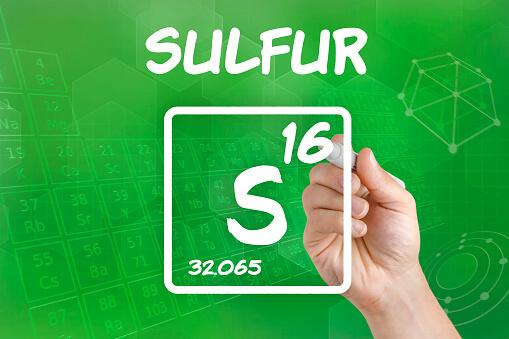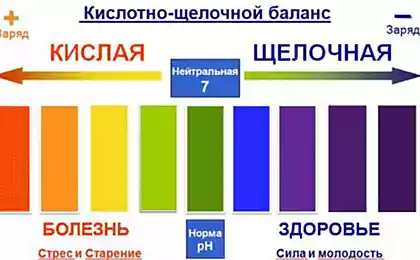802
Sulfur — mineral beauty
In animals and humans, sulfur performs a essential functions: ensures the spatial organization of protein molecules necessary for their functioning, protects cells, tissues, and the way biochemical synthesis from oxidation, and whole body from the toxic action of foreign substances.
The daily requirement of the human body – 0,5–3 g (according to others – 4-5 g).

Sulfur enters the body with food products consisting of inorganic and organic compounds. A large part of the sulphur enters the body composed of amino acids. Inorganic sulfur compounds (salts of sulphuric and sulphurous acids) are not absorbed and are excreted with the feces. Organic protein compounds are split and absorbed in the intestine. The sulfur content in the body of an adult is about 0.16% (110 g per 70 kg of body weight). Sulfur is found in all human tissues, especially a lot of it in muscles, skeleton, liver, nervous tissue, blood. Also rich in sulfur surface layers of the skin where the sulfur is part of keratin and melanin. In the tissues of the sulfur is in various forms – as inorganic (sulfates, sulfites, sulfides, thiocyanates, etc.), and organic (thiols, thioethers, sulfonic acids, thiourea, etc.). In the form of sulfate anion sulfur is present in liquid mediums of an organism. Sulfur atoms are part of molecules essential amino acids (cystine, cysteine, methionine), hormones (insulin, calcitonin), vitamins (Biotin, thiamin), glutathione, taurine and other important body compounds. In their composition sulfur participates in redox reactions, tissue respiration, energy production, transmission of genetic information, and perform many other important functions. Sulfur is a component of the structural protein collagen. Chondroitin sulfate is present in the skin, cartilage, nails, ligaments and valves myocardium. Important sulfur-containing metabolites are also hemoglobin, heparin, cytochromes, fibrinogen and sulfolipids. Sulphur is excreted mainly with urine in the form of neutral sulphur and inorganic sulphates, a smaller portion of sulfur is discharged through the skin and lungs, and excreted mainly in the urine in the form of SO42–. Endogenous sulphuric acid produced in the body, participates in the neutralization of toxic compounds (phenol, indole, etc.) that are produced by the microflora, and also attributes alien to the body substances, including drugs and their metabolites. With the formation of harmless compounds – conjugates that are then excreted.
The exchange of sulfur is controlled by factors that also exert regulatory effects on protein metabolism (hormones of pituitary, thyroid, adrenals, sexual glands). The biological role in the human body In the human body sulfur is an indispensable component of cells, enzymes, hormones, in particular insulin secreted by the pancreas, and sulfur-containing amino acids (methionine, cysteine, taurine and glutathione).
Sulphur enters into the composition of biologically active substances (histamine, Biotin, lipoic acid, etc.). The active centers of the molecules of a number of enzymes consists of SH–groups, which participate in many enzymatic reactions, in particular, in the creation and stabilization of the native three-dimensional structure of proteins, and in some cases, act directly as the catalytic centers of enzymes, they are part of various coenzymes including coenzyme A.
The sulfur is part of hemoglobin, is found in all body tissues, necessary for the synthesis of collagenand protein that determines the structure of the skin.
In the cell, the sulfur provides a subtle and complex process like energy transfer: transfers the electrons taking on a free orbital, one of the unpaired electrons of oxygen. Sulfur is involved in the fixation and transport of methyl groups. Sulfur disinfects the blood, increases the body's resistance to bacteria and protects the protoplasm of cells, facilitates the implementation of needed by the body oxidation reactions, increases bile secretion, protects against the harmful effects of toxic substances, protects the body from the harmful effects of radiation and environmental pollution, thereby slowing the aging process. This explains the high demand of the organism in this element. Synergists and antagonists of sulfur To elements that promote the assimilation of sulfur, apply fluoride, and iron, and the antagonists – arsenic, barium, lead, molybdenum and selenium. Signs of sulfur deficiency: constipation, allergies, dull hair, brittle nails, high blood pressure, joint pain, tachycardia, high blood sugar and high triglycerides in the blood. In severe cases, fatty degeneration of the liver, bleeding in the kidney, disorders of protein and carbohydrate metabolism, over-stimulation of the nervous system, irritability.
The sulphur deficiency in the body does not happen often, because most food contains a sufficient amount of. In recent decades, one of the sources of excess supply of sulfur in the human body become sulfur-containing compounds (sulfites) that are added to many food products, alcoholic and soft drinks as preservatives. Especially a lot of sulfites in meats, potatoes, fresh vegetables, beer, cider, ready-made salads, the vinegar, the dyes fault. Perhaps the consumption of sulphite, which is constantly increasing, partly to blame for the increased incidence of asthma. It is known, for example, that 10% of patients with asthma exhibit increased sensitivity to sulfites (i.e., sensitized to them). The main manifestations of excess sulfur in the body: itching, rashes, abrasions, redness and swelling of the conjunctiva; the appearance of small point defects in the cornea; aching of the eyebrows and the eyeballs, sensation of sand in eyes; photophobia, lacrimation, weakness, headaches, dizziness, nausea, catarrh of the upper respiratory tract, bronchitis; hearing impaired, digestive disorders, diarrhea, decrease of body weight; anemia, mental disorder, decreased intelligence. Sulfur is necessary: in pulmonary tuberculosis, rheumatism, inflammations, heartburn, arthritis, rhinitis, hair problems (when the amount of creatine in them is below normal), joint pain, parasitic infection, irritable bowel syndrome, carpal tunnel syndrome (occupational disease of programmers), and diseases of the skin and nails.

Food sources of sulfur: vegetables: garlic, onion, cabbage, broccoli, Brussels sprouts, cauliflower, kelp (seaweed), chili pepper, black radish, celery, asparagus, horseradish, mustard white and black; greens: arugula, celery greens, parsley and garlic; nuts and seeds: poppy, macadamia, almonds, Brazilian nuts, walnuts, pine nuts, sunflower seeds, pumpkin seeds, pistachios, hazelnuts; legumes: beans, peas, soybeans, beans, lentils; cereals: maize, oats, soft wheat, hard wheat; wheat germ; eggs (yolks), fish, meat.
Sulfur is the primary mineral that makes garlic the "king of plants". published
Vital CHROME: say goodbye to diabetes and obesity!
Talking about pain in different parts of the body
Source: www.pharmacognosy.com.ua/index.php/makro-i-mikro-chudesa/sera-mineral-krasoty
The daily requirement of the human body – 0,5–3 g (according to others – 4-5 g).

Sulfur enters the body with food products consisting of inorganic and organic compounds. A large part of the sulphur enters the body composed of amino acids. Inorganic sulfur compounds (salts of sulphuric and sulphurous acids) are not absorbed and are excreted with the feces. Organic protein compounds are split and absorbed in the intestine. The sulfur content in the body of an adult is about 0.16% (110 g per 70 kg of body weight). Sulfur is found in all human tissues, especially a lot of it in muscles, skeleton, liver, nervous tissue, blood. Also rich in sulfur surface layers of the skin where the sulfur is part of keratin and melanin. In the tissues of the sulfur is in various forms – as inorganic (sulfates, sulfites, sulfides, thiocyanates, etc.), and organic (thiols, thioethers, sulfonic acids, thiourea, etc.). In the form of sulfate anion sulfur is present in liquid mediums of an organism. Sulfur atoms are part of molecules essential amino acids (cystine, cysteine, methionine), hormones (insulin, calcitonin), vitamins (Biotin, thiamin), glutathione, taurine and other important body compounds. In their composition sulfur participates in redox reactions, tissue respiration, energy production, transmission of genetic information, and perform many other important functions. Sulfur is a component of the structural protein collagen. Chondroitin sulfate is present in the skin, cartilage, nails, ligaments and valves myocardium. Important sulfur-containing metabolites are also hemoglobin, heparin, cytochromes, fibrinogen and sulfolipids. Sulphur is excreted mainly with urine in the form of neutral sulphur and inorganic sulphates, a smaller portion of sulfur is discharged through the skin and lungs, and excreted mainly in the urine in the form of SO42–. Endogenous sulphuric acid produced in the body, participates in the neutralization of toxic compounds (phenol, indole, etc.) that are produced by the microflora, and also attributes alien to the body substances, including drugs and their metabolites. With the formation of harmless compounds – conjugates that are then excreted.
The exchange of sulfur is controlled by factors that also exert regulatory effects on protein metabolism (hormones of pituitary, thyroid, adrenals, sexual glands). The biological role in the human body In the human body sulfur is an indispensable component of cells, enzymes, hormones, in particular insulin secreted by the pancreas, and sulfur-containing amino acids (methionine, cysteine, taurine and glutathione).
Sulphur enters into the composition of biologically active substances (histamine, Biotin, lipoic acid, etc.). The active centers of the molecules of a number of enzymes consists of SH–groups, which participate in many enzymatic reactions, in particular, in the creation and stabilization of the native three-dimensional structure of proteins, and in some cases, act directly as the catalytic centers of enzymes, they are part of various coenzymes including coenzyme A.
The sulfur is part of hemoglobin, is found in all body tissues, necessary for the synthesis of collagenand protein that determines the structure of the skin.
In the cell, the sulfur provides a subtle and complex process like energy transfer: transfers the electrons taking on a free orbital, one of the unpaired electrons of oxygen. Sulfur is involved in the fixation and transport of methyl groups. Sulfur disinfects the blood, increases the body's resistance to bacteria and protects the protoplasm of cells, facilitates the implementation of needed by the body oxidation reactions, increases bile secretion, protects against the harmful effects of toxic substances, protects the body from the harmful effects of radiation and environmental pollution, thereby slowing the aging process. This explains the high demand of the organism in this element. Synergists and antagonists of sulfur To elements that promote the assimilation of sulfur, apply fluoride, and iron, and the antagonists – arsenic, barium, lead, molybdenum and selenium. Signs of sulfur deficiency: constipation, allergies, dull hair, brittle nails, high blood pressure, joint pain, tachycardia, high blood sugar and high triglycerides in the blood. In severe cases, fatty degeneration of the liver, bleeding in the kidney, disorders of protein and carbohydrate metabolism, over-stimulation of the nervous system, irritability.
The sulphur deficiency in the body does not happen often, because most food contains a sufficient amount of. In recent decades, one of the sources of excess supply of sulfur in the human body become sulfur-containing compounds (sulfites) that are added to many food products, alcoholic and soft drinks as preservatives. Especially a lot of sulfites in meats, potatoes, fresh vegetables, beer, cider, ready-made salads, the vinegar, the dyes fault. Perhaps the consumption of sulphite, which is constantly increasing, partly to blame for the increased incidence of asthma. It is known, for example, that 10% of patients with asthma exhibit increased sensitivity to sulfites (i.e., sensitized to them). The main manifestations of excess sulfur in the body: itching, rashes, abrasions, redness and swelling of the conjunctiva; the appearance of small point defects in the cornea; aching of the eyebrows and the eyeballs, sensation of sand in eyes; photophobia, lacrimation, weakness, headaches, dizziness, nausea, catarrh of the upper respiratory tract, bronchitis; hearing impaired, digestive disorders, diarrhea, decrease of body weight; anemia, mental disorder, decreased intelligence. Sulfur is necessary: in pulmonary tuberculosis, rheumatism, inflammations, heartburn, arthritis, rhinitis, hair problems (when the amount of creatine in them is below normal), joint pain, parasitic infection, irritable bowel syndrome, carpal tunnel syndrome (occupational disease of programmers), and diseases of the skin and nails.

Food sources of sulfur: vegetables: garlic, onion, cabbage, broccoli, Brussels sprouts, cauliflower, kelp (seaweed), chili pepper, black radish, celery, asparagus, horseradish, mustard white and black; greens: arugula, celery greens, parsley and garlic; nuts and seeds: poppy, macadamia, almonds, Brazilian nuts, walnuts, pine nuts, sunflower seeds, pumpkin seeds, pistachios, hazelnuts; legumes: beans, peas, soybeans, beans, lentils; cereals: maize, oats, soft wheat, hard wheat; wheat germ; eggs (yolks), fish, meat.
Sulfur is the primary mineral that makes garlic the "king of plants". published
Vital CHROME: say goodbye to diabetes and obesity!
Talking about pain in different parts of the body
Source: www.pharmacognosy.com.ua/index.php/makro-i-mikro-chudesa/sera-mineral-krasoty























